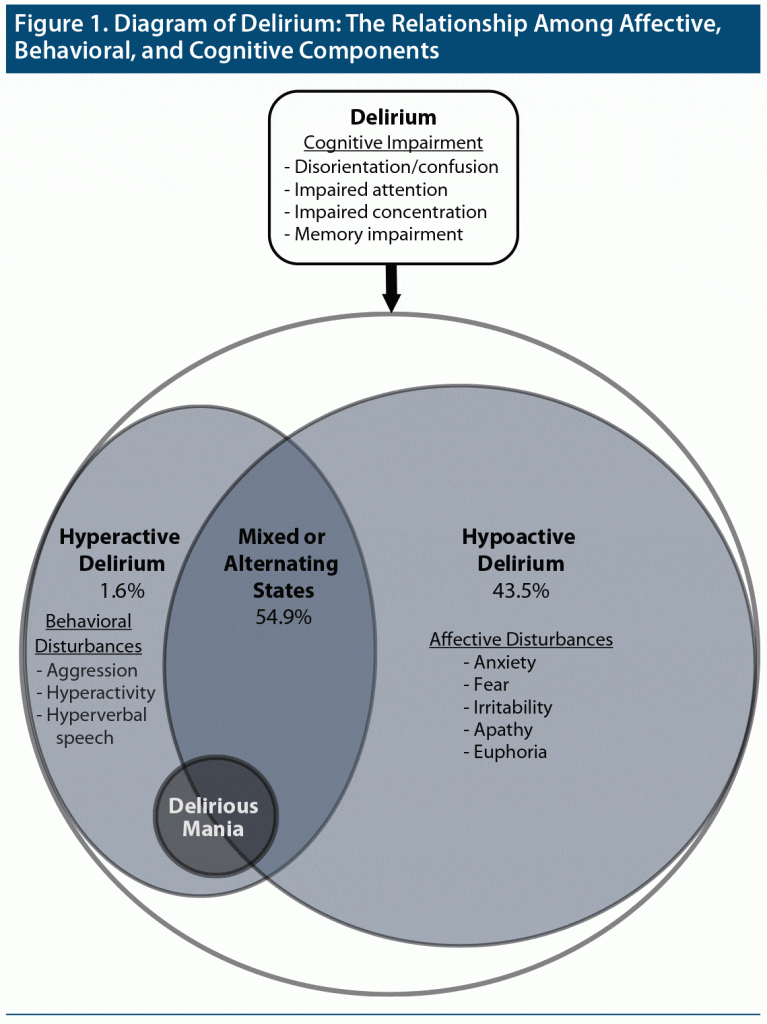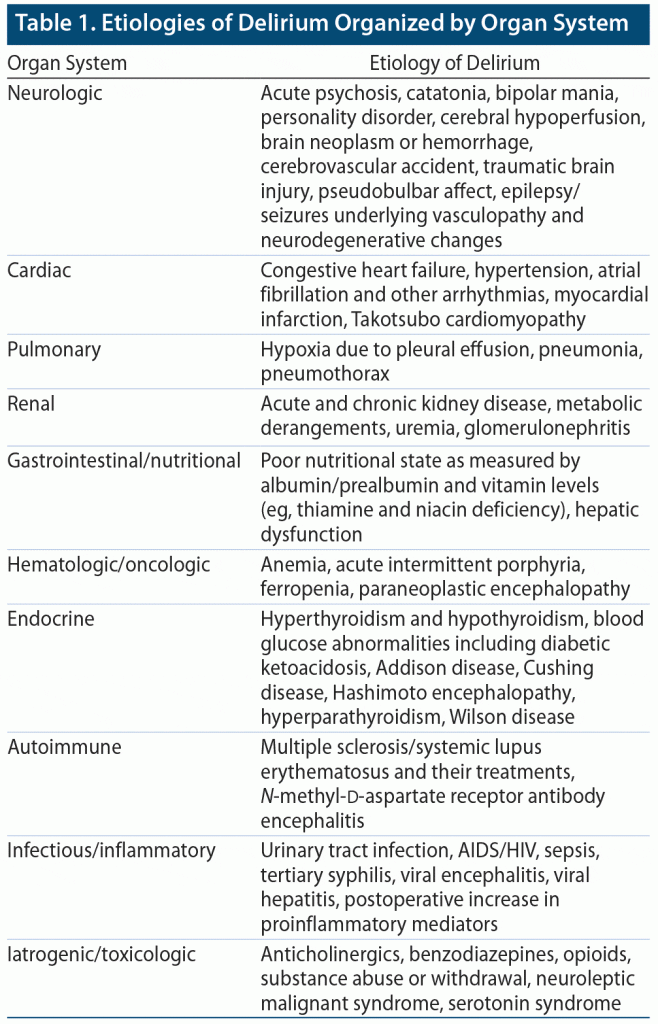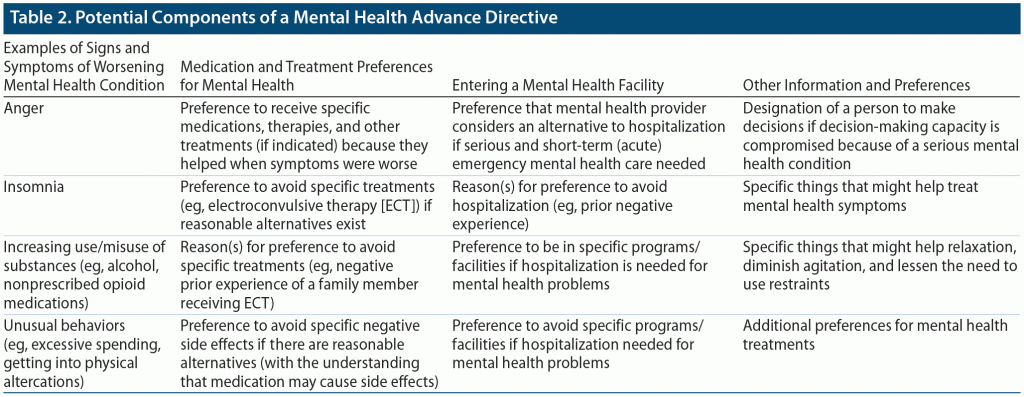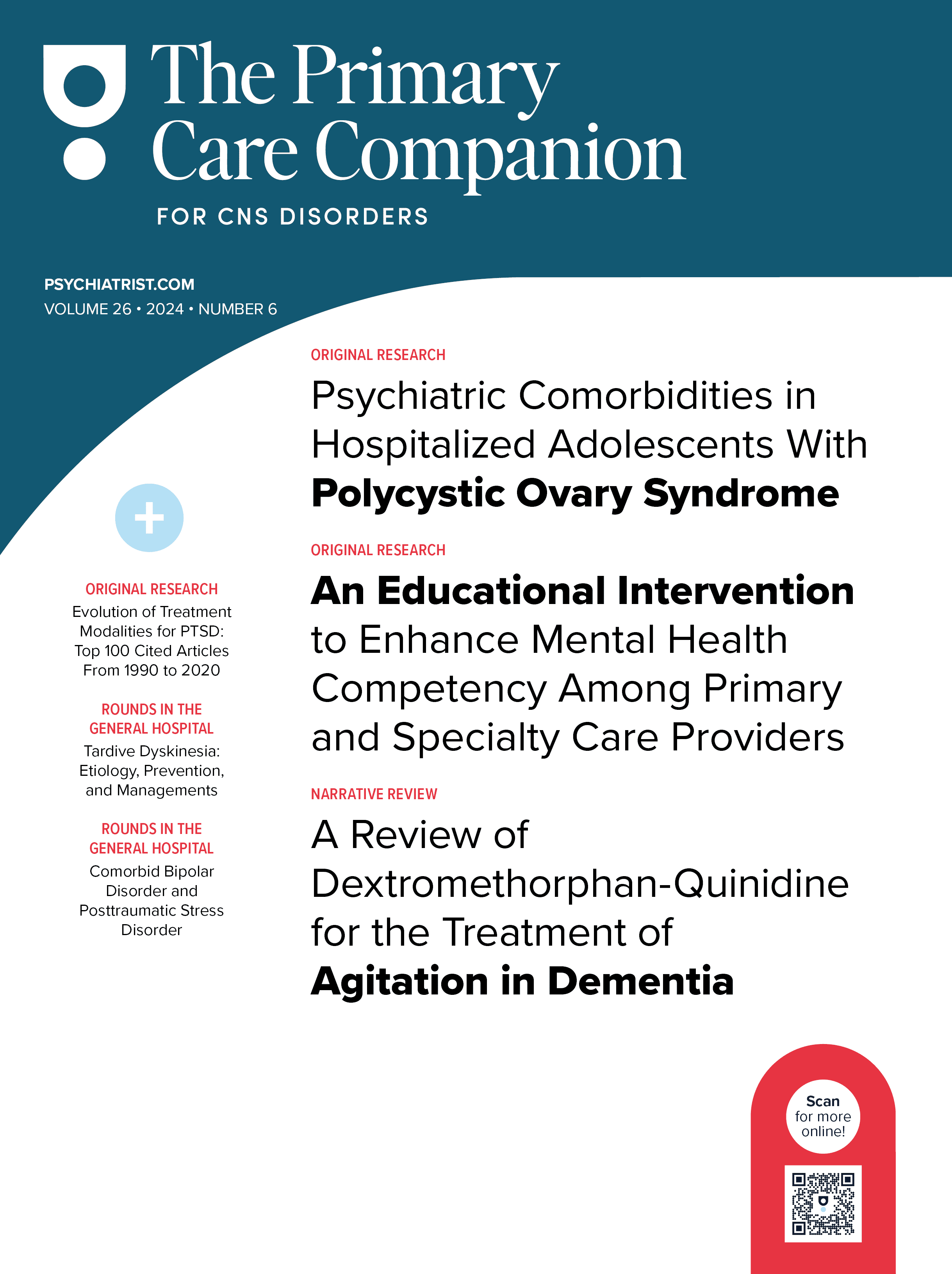LESSONS LEARNED AT THE INTERFACE OF MEDICINE AND PSYCHIATRY
The Psychiatric Consultation Service at Massachusetts General Hospital sees medical and surgical inpatients with comorbid psychiatric symptoms and conditions. During their twice-weekly rounds, Dr Stern and other members of the Consultation Service discuss diagnosis and management of hospitalized patients with complex medical or surgical problems who also demonstrate psychiatric symptoms or conditions. These discussions have given rise to rounds reports that will prove useful for clinicians practicing at the interface of medicine and psychiatry.
Prim Care Companion CNS Disord 2021;23(1):20f02744
To cite: Arsan C, Baker C, Wong J, et al. Delirious mania: an approach to diagnosis and treatment. Prim Care Companion CNS Disord. 2021;23(1):20f02744.
To share: https://doi.org/10.4088/PCC.20f02744
© Copyright 2021 Physicians Postgraduate Press, Inc.
aDepartment of Psychiatry, Keck School of Medicine at the University of Southern California, Los Angeles, California
bDepartment of Internal Medicine, Brigham and Women’s Hospital, Boston, Massachusetts
cDepartment of Psychiatry, Columbia University Irving Medical Center, New York, New York
dDepartment of Psychiatry, Geisel School of Medicine at Dartmouth, Hanover, New Hampshire
eDepartment of Mental Health and Behavioral Sciences, White River Junction VA Medical Center, White River Junction, Vermont
fVA National Center for Patient Safety, White River Junction, Vermont
gDepartment of Psychiatry, Massachusetts General Hospital, Boston, Massachusetts
hHarvard Medical School, Boston, Massachusetts
IBurlington Lakeside VA Community Based Outpatient Clinic, Burlington, Vermont
*Corresponding author: Cybele Arsan, MD, Keck School of Medicine of University of Southern California, 1975 Zonal Ave, Los Angeles, California 90033 ([email protected]).
Have you ever wondered what is responsible for an altered mental status with agitated behaviors? Have you been uncertain about when and how to evaluate a patient with such signs and symptoms? Have you been flummoxed by how to optimize treatment of such an individual over the short and long term? If you have, then the following case vignette and discussion (which illustrates the complexity of diagnosing and treating a patient with confusion and manic excitement) should prove useful.
Case Vignette Part 1
Mr A, a 61-year-old man, was transferred to our psychiatric unit for the management of acute mania and lithium toxicity (lithium level: 1.6 mmol/L; reference range, 0.8–1.2 mmol/L) in the setting of acute kidney injury. His psychiatric history was notable for bipolar affective disorder type I and an episode of probable delirious mania 17 years earlier (which resolved following treatment with lithium and olanzapine). His medical history included poorly controlled essential hypertension, diabetes mellitus type 2, hypothyroidism, and gastroesophageal reflux disease.
Law enforcement initially brought Mr A to an outside hospital after they witnessed him driving erratically. His wife reported that 1 week prior to admission Mr A started exhibiting hyperverbal speech, pacing (“walking miles a day”), a decreased need for sleep, and an increase in goal-directed activities (which she described as “beginning many projects without finishing them”). His toxicology screen was negative for illicit substances. Despite improvement in renal function and diabetic control, his agitated and disorganized behavior continued (eg, he bit himself and tore out his fingernails). Oral valproic acid, oral lorazepam, and oral olanzapine were initiated with no significant improvement.
After 12 days in the outside hospital, Mr A was transferred to our inpatient psychiatric unit for treatment of florid mania. Lorazepam was gradually tapered, and olanzapine and valproic acid were titrated to their respective maximum recommended dosages without subsequent improvement of his behaviors (eg, pacing, insomnia, labile mood). Mr A’s sensorium fluctuated (eg, he was confused and disoriented to place and time), and a presumptive diagnosis of delirious mania was made. He was transferred to the medical floor (with psychiatric consultation-liaison service involvement) for further workup of altered mental status. Possible causes for delirium including polypharmacy, urinary tract infection, active cellulitis, uncontrolled diabetes mellitus type 2, constipation, acute kidney injury, hypertension, nephrogenic diabetes insipidus, and benign prostatic hypertrophy were addressed without significant improvement. Neuroimaging (magnetic resonance imaging [MRI] of the brain) was unremarkable with no evidence of hemorrhage or space-occupying lesion. A trial of intravenous lorazepam failed to improve his mental status. Concerns about corrected QT value (QTc) prolongation and Torsades de pointes (TdP) precluded the use of haloperidol for Mr A given his electrocardiogram (ECG) showed a QTc interval reading >c500 msec.
Mr A required intermittent restraints due to significant physical aggression toward staff members (including a traumatic brain injury suffered by a nurse). For the safety of the patient and staff, he was sedated in the intensive care unit (ICU) using dexmedetomidine for 2½ days with only mild resolution of his manic symptoms upon emergence from sedation.
What Is Delirious Mania?
Delirious mania is a diagnosis that lacks formalized criteria. It has been defined as “a syndrome of the acute onset of the excitement, grandiosity, emotional lability, delusions, and insomnia characteristic of mania, and the disorientation and altered consciousness characteristic of delirium.”1(p54) Clinical onset and course are notable for acute onset and rapid progression of symptoms (ie, hours or days), with a fluctuating course that alternates between psychosis, catatonic and manic features, and delirium.2 Individuals suffering from this syndrome usually have poor/absent recall of events that occurred during the episode once resolved.2 The putative etiologies of delirious mania have been well considered but remain uncertain. Klerman3 considered delirious mania to be a variant of classical bipolar disorder. Mann et al4 emphasized the diversity of underlying medical and neuropsychiatric etiologies of delirious mania. Taylor and Fink5 classified delirious mania as a variant of catatonia (ie, excited catatonia). Shorter and Fink6 observed that although psychiatrists have great difficulty managing delirious psychotic activity (often preferring to leave management of violent behavior to law enforcement), presentations of delirious mania lie within the realm of psychiatric medicine.
How Is Delirious Mania Diagnosed?
While there are no standardized diagnostic guidelines available for delirious mania, the simultaneous presence of delirium (including alterations in the “ABCs” of affect, behavior, and cognition) and manic symptoms (including psychomotor agitation and pressured speech) are clinical indicators. Figure 1 shows relative motoric subtypes of delirium,7 reflecting the complex presentation of delirious mania. Catatonic signs and symptoms may include mutism, grimacing, stereotypy, mannerisms, rigidity, negativism, automatic obedience, and echopraxia/echolalia (ie, mimicking of examiner’s movements/speech).8 Potentially helpful rating scales for its evaluation include the Bush-Francis Catatonia Rating Scale9 to identify catatonia, the Confusion Assessment Method for the Intensive Care Unit 10 for recognition of delirium, and the Young Mania Rating Scale11 to rate manic symptoms.

What Is the Differential Diagnosis and Workup of Delirious Mania?
Clinicians must be vigilant for neuro-medical etiologies of delirious mania, as it is a syndrome found among those with autoimmune and paraneoplastic conditions (eg, anti-N-methyl-d-aspartate [NMDA] receptor encephalitis12), metabolic derangements, and neurologic disorders. Often, presentations of delirious mania are unaccompanied by organic etiologies. However, reversible and life-threatening causes of delirium should be worked up and ruled out.
Given that the differential diagnosis for altered mental status is broad, the workup should start with reversible and life-threatening causes as recalled by use of the mnemonic “rule out the WHIMPS.”13 Each letter of this acronym signifies 1 or more of the following conditions: Wernicke encephalopathy and withdrawal; hypoglycemia, hypoxia, hypoperfusion of the central nervous system, and hypertensive encephalopathy (eg, posterior reversible encephalopathy syndrome); infections and intracranial processes; metabolic derangements (such as hyponatremia/ hypernatremia, hypocalcemia/hypercalcemia, and hyperammonemia); poisons (eg, leading to anticholinergic excess); and seizures.
Table 1 includes a list of conditions associated with altered mental status and is organized systematically by organ system to display the wide differential diagnosis of delirious mania. Laboratory tests should be performed, including complete metabolic panel, complete blood count with differential, urinalysis, and vitamin (eg, B12/folate) and nutritional studies (eg, albumin/prealbumin), and pregnancy screening for female patients of reproductive age should be ordered to assist with the workup of delirious mania to rule out these potential etiologies.2 Creatinine phosphokinase, iron studies, and blood and urine cultures should be ordered if there is fever, rigidity, or autonomic instability. If clinically indicated, an electroencephalogram (EEG), arterial blood gas, serum drug levels (eg, lithium), chest x-ray, ECG, thyroid and liver function tests, lumbar puncture, neuroimaging (eg, computed tomography or MRI of the brain), and other blood serum tests (eg, human immunodeficiency virus, hepatitis A/B/C, syphilis, Lyme disease, antinuclear antibodies) can be ordered.2

How Can Delirious Mania Be Managed?
Treatment of delirious mania typically targets underlying neuro-medical causes; however, there is a first-line role for benzodiazepines, especially if catatonic features are present, despite their usual contraindication in delirium.2 A lorazepam challenge usually starts with 2 mg of lorazepam (intravenous is easiest to administer; however, oral and intramuscular formulations are potential options) with observation for effect.8 If there is no effect, the same dose may be repeated in 3 hours and again after another 3 hours if necessary, with a target dose of at least 6 mg over a 24-hour period. If clinical response is favorable, ongoing treatment of 6 mg (and up to 20 mg) of lorazepam per day in divided doses is indicated. Close monitoring for respiratory suppression, or alternatively for paradoxical worsening of confusion, is recommended during lorazepam challenge. If no improvement occurs, electroconvulsive therapy (ECT) should be considered.2 ECT is the most effective treatment to resolve symptoms and signs of delirious mania within 2 to 4 sessions, although 12 or more ECT sessions may be required on occasion.2 Benzodiazepines should be held during the morning hours prior to ECT sessions, as they increase seizure threshold and interfere with effective convulsive activity. Moreover, antiepileptic agents used for psychiatric conditions (eg, valproic acid, carbamazepine, lamotrigine) should be held for ECT unless they are part of a specific treatment plan for epilepsy.2 Bitemporal (compared to unilateral) ECT is most effective for treatment of catatonic features, although it is associated with potentially more prominent cognitive side effects.8 If catatonic or malignant features (eg, rigidity, fever, autonomic instability) are present, antipsychotics should be discontinued, as they may precipitate neuroleptic malignant syndrome and lead to significant morbidity and mortality. Antipsychotics may be used if catatonic malignant features are not present. There is a potential role for mood stabilizers in delirious mania; however, response is much slower than with ECT or benzodiazepines (eg, days/wk vs minutes/h).2
What Are Challenges Involved With Administering ECT to Patients With Delirious Mania?
ECT has been an effective treatment for cases of treatment-resistant delirious mania.1 Advantages of ECT as compared to pharmacologic management are 2-fold: it typically shows a prompt response and it carries less risk of worsening delirium. However, ECT requires an elaborate informed consent process compared to other psychiatric treatments. Each state has different laws that closely regulate its use. Per Harris,14 “There exists no widely accepted, validated, replicated, and standardized test for competency in the context of ECT.”(p406) Ganzini et al15 suggested that “In patients who are only intermittently incapacitated, important discussions should be timed to correspond to periods when the patient is capable of making decisions.”(p265)
The American Psychiatric Association recommends deferring to the patient’s previous wishes in cases of patients refusing consent for ECT.16 However, there is controversy around the administration of involuntary ECT in life-threatening cases such as with delirious mania. There is a potential place for involuntary ECT in the event of serious threat to self or others.17 In the case of Mr A, threats to self and to others were considered and presented to the family, but this did not change their opinions about the treatment.
Developing psychiatric advance directives for patients with psychotic and bipolar disorder that outline wishes for treatment if a patient lacks full decision-making capacity can increase the therapeutic alliance.18 The discussion relating to advance directives often opens a dialog about preferences that ultimately help to align with patient goals for treatment. However, advance directives are underutilized as part of routine care and require institution-wide clinician acceptance. A recent analysis at the White River Junction, Vermont Veterans Administration Medical Center estimated that only 40% of patients on the medical floor had any advance directives on file upon admission; these were primarily directives related to end-of-life care or resuscitation preferences, not psychiatric advance directives. It should also be noted that states vary in their recognition and application of psychiatric advance directives. For patients such as Mr A, a psychiatric advance directive may include reviewing prodromal signs and need for early treatment, ECT treatment choice, the use of QTc-prolonging agents, and a conversation about the difference in treatment approach between a simple manic episode versus a life-threatening episode of delirious mania (Table 2).

Case Vignette Part 2
Mr A could not be transferred back to the psychiatric unit after stabilization of his underlying medical conditions given state law regulations about involuntary commitment for patients with signs of delirium. Thus, primary team ownership was reassigned to psychiatry with internal medicine consultation on the medical ward. Caring for this behaviorally disinhibited patient caused significant apprehension among medical ward staff and interfered with effective care. High visibility and frequent communication with the primary psychiatry team appeared to relieve team members’ concerns about Mr A’s appropriateness for placement on the medical ward and enhanced quality of care.19
ECT was discussed as a potential treatment modality; however, Mr A’s previously stated wishes were to refuse ECT, citing his sister’s negative ECT treatment experience, which included subsequent long-term cognitive deficits. The family was consulted for surrogate decision making given Mr A’s lack of capacity to refuse ECT, and they decided not to pursue this treatment despite extensive discussions about its possible benefits. Instead, his family opted for ongoing titration of medications.
Eventually, the benefits of trialing intravenous haloperidol outweighed its potential risks (eg, risk of QTc prolongation, TdP). Repeat ECG showed a QTc of 440 msec, and olanzapine was switched to haloperidol, which led to significant improvement of his manic signs and symptoms and gradual improvement of his mental status. He was discharged home after more than 2 months in the hospital and 1 week after transitioning from olanzapine to haloperidol.
Discussion
The case of Mr A illustrates the difficulty in caring for a behaviorally disinhibited patient with protracted delirious mania. Cases of delirious mania exist at the interface of psychiatry and medicine and create challenges in the management of medical, psychiatric, and behavioral needs. Patients with bipolar disorder and comorbid chronic kidney injury currently or formerly receiving long-term therapy with lithium are at increased risk for developing delirious mania.20 Moreover, abrupt lithium discontinuation (such as that which occurred due to Mr A’s lithium toxicity) in patients with bipolar disorder and comorbid chronic medical conditions (especially chronic kidney disease) increases risk for mania that is refractory to conventional medication treatment.20 The gold standard treatment for delirious mania is ECT, particularly when benzodiazepine treatment is ineffective. However, this was not a viable option for Mr A due to his prior expressed wishes. Earlier use of a more potent dopamine (D2) receptor antagonist such as haloperidol could be trialed despite concerns of QTc prolongation. While there is a risk of TdP with haloperidol (given orally or intravenously), the risk of inducing TdP appears to be quite low if other potential risk factors (eg, polypharmacy, a prolonged QT interval at baseline, and the coadministration of medications) are taken into consideration.21 Although the search for effective treatment was challenging, witnessing Mr A’s return to his baseline was rewarding and perceived as successful management of delirious mania.
Submitted: July 8, 2020; accepted October 22, 2020.
Published online: February 18, 2021.
Potential conflicts of interest: Dr Stern is an employee of the Academy of Consultation-Liaison Psychiatry and has received royalties from Elsevier and the Massachusetts General Hospital Psychiatry Academy. Drs Arsan, Baker, Wong, Scott, Felde, Mills, and Rustad report no conflicts of interest related to the subject of this article.
Funding/support: None.
Disclaimer: Drs Scott, Felde, Mills, and Rustad are employed by the United States Department of Veterans Affairs, but the views expressed in this manuscript do not reflect those of the Department of Veterans Affairs or the US government.
Clinical Points
- Delirious mania is a complex and often misdiagnosed condition that can be life threatening.
- Clinicians must be vigilant for neuro-medical etiologies of delirious mania, as it is a syndrome found among patients with autoimmune conditions, metabolic derangements, and neurologic disorders.
- Electroconvulsive therapy is the gold standard treatment for cases of delirious mania, and psychiatric advance directives about the use of this treatment should be prioritized.
References (21)

- Fink M. Delirious mania. Bipolar Disord. 1999;1(1):54–60. PubMed CrossRef NLM
- Jacobowski NL, Heckers S, Bobo WV. Delirious mania: detection, diagnosis, and clinical management in the acute setting. J Psychiatr Pract. 2013;19(1):15–28. PubMed CrossRef NLM
- Klerman GL. The spectrum of mania. Compr Psychiatry. 1981;22(1):11–20. PubMed CrossRef NLM
- Mann SC, Caroff SN, Bleier HR, et al. Lethal catatonia. Am J Psychiatry. 1986;143(11):1374–1381. PubMed CrossRef NLM
- Taylor MA, Fink M. Catatonia in psychiatric classification: a home of its own. Am J Psychiatry. 2003;160(7):1233–1241. PubMed CrossRef NLM
- Shorter E, Fink M. Delirious mania and febrile catatonia. In: Shorter E, Fink M, eds. The Madness of Fear: A History of Catatonia. New York, NY: Oxford University Press; 2018:93–107.
- Peterson JF, Pun BT, Dittus RS, et al. Delirium and its motoric subtypes: a study of 614 critically ill patients. J Am Geriatr Soc. 2006;54(3):479–484. PubMed CrossRef NLM
- Rustad JK, Landsman HS, Ivkovic A, et al. Catatonia: an approach to diagnosis and treatment. Prim Care Companion CNS Disord. 2018;20(1):17f02202. PubMed CrossRef NLM
- Bush G, Fink M, Petrides G, et al. Catatonia, I: rating scale and standardized examination. Acta Psychiatr Scand. 1996;93(2):129–136. PubMed CrossRef NLM
- Ely EW, Margolin R, Francis J, et al. Evaluation of delirium in critically ill patients: validation of the Confusion Assessment Method for the Intensive Care Unit (CAM-ICU). Crit Care Med. 2001;29(7):1370–1379. PubMed CrossRef NLM
- Young RC, Biggs JT, Ziegler VE, et al. A rating scale for mania: reliability, validity and sensitivity. Br J Psychiatry. 1978;133(5):429–435. PubMed CrossRef NLM
- Restrepo-Martínez M, Chacón-González J, Bayliss L, et al. Delirious mania as a neuropsychiatric presentation in patients with anti-N-methyl-D-aspartate receptor encephalitis. Psychosomatics. 2020;61(1):64–69. PubMed CrossRef NLM
- Rustad JK, Cho T, Chemali Z, et al. The recognition and treatment of rabies: a case report and discussion. Psychosomatics. 2015;56(2):196–201. PubMed CrossRef NLM
- Harris V. Electroconvulsive therapy: administrative codes, legislation, and professional recommendations. J Am Acad Psychiatry Law. 2006;34(3):406–411. PubMed NLM
- Ganzini L, Volicer L, Nelson WA, et al. Ten myths about decision-making capacity. J Am Med Dir Assoc. 2004;5(4):263–267. PubMed CrossRef NLM
- Jaffe R. The practice of electroconvulsive therapy, recommendations for treatment, training, and privileging: a task force report of the American Psychiatric Association, 2nd ed. Am J Psychiatry. 2002;159(2):331. CrossRef
- Karmacharya R, England ML, Ongür D. Delirious mania: clinical features and treatment response. J Affect Disord. 2008;109(3):312–316. PubMed CrossRef NLM
- Maître E, Debien C, Nicaise P, et al. Advanced directives in psychiatry: a review of the qualitative literature, a state-of-the-art and viewpoints [in French]. Encephale. 2013;39(4):244–251. PubMed NLM
- Kontos N, Freudenreich O, Querques J. Ownership, responsibility and hospital care: lessons for the consultation psychiatrist. Gen Hosp Psychiatry. 2008;30(3):257–262. PubMed CrossRef NLM
- Zaidi M, Champ M, Brown A, et al. 162 Post-lithium delirious mania in patients with bipolar disorder. CNS Spectr. 2020;25(2):303–304. CrossRef
- Huffman JC, Stern TA. QTc prolongation and the use of antipsychotics: a case discussion. Prim Care Companion J Clin Psychiatry. 2003;5(6):278–281. PubMed CrossRef NLM
Please sign in or purchase this PDF for $40.
Save
Cite




